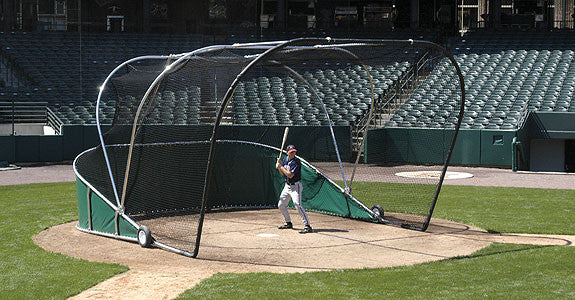Rapid Fire Ground Balls
This is a great way to end your traditional infielders’ positional work during practice. At the conclusion of your normal ground ball work at each position (third to first, short to first, second to first, 6-4-3 double play, 5-4-3 double play, 3-6-3 double play, etc.) have your infielders all gather at their respective positions and prepare them for rapid fire ground balls.
For example, your third baseman will be at his or her usual spot while the coach is hitting a fresh ground ball the split second he/she throws the ball across the diamond. This will make the fielder have a constant head on their shoulders and be prepared for whatever may come next (a ball hit to their left, hit to their right, a slow roller, a high chopper, etc.).
Since the ground balls are coming at a non-traditional rate, this will create a fun and competitive environment for your team and coaches. You’re also likely get some players that begin diving at balls and getting dirty, which will certainly get a rise from their teammates. Just make sure they’re still utilizing proper footwork and mechanics, as this drill can become a little bit chaotic.
This take time and work to get players to learn how but it is a great drill and will pay off with ball handling in the game.
CREDIT TO: thehittingvault.com
In this time of having to stay home bound players are board and on the computer for many hours. But while I advocate for them getting outside and being active there certainly are some activities that they can do on that computer that will improve their mental knowledge of the game and maybe give them insight.
Here's a few that might work for you but please encourage your player and/or yourselves to look the sites using Google or any other search engine and specific questions.
Stay mentally sharp as well as physically getting ready for baseball and softball to start.
======================
http://www.freeonlinebaseballgames.com/
====================
Try this type activity while you are home safe.
Question on how to Tag out runners in the basepaths
Bucket Drill
by Randy Huff
(Darien, CT)
Coach sits on a bucket behind pitchers mound (Honey Hole). He will roll slow rollers to either SS or 2nd base.
The drill is designed to have the middle infielders roll a double play, with each player doing a little hop after they throw the ball to first base, signifying a runner sliding into them.
The coach gets to watch how the play unfolds, like watching how the fielders field the ball, flip or throw to 2nd base and watching the small hop after the ball is released.
The coach can have a lot of fun with the drill by putting the middle infielders on a stop watch to see who can do it the fastest, kids love the drill.
Then move bucket and coach by home plate and have players go to 3rd base. Have a coach on 3rd base as a runner.
Roll ball to the players at 3rd base, make sure they look the runner back before firing ball to 1st base. Then make sure 1st baseman catches ball for out and pops off base to look at home for the play.
If the player forgets to look coach back, have coach score from 3rd. This is all explained with less than 2 outs of course.
When no one around, improve by yourself, one man drills
One of the biggest concerns that coaches and associations have these days is with pitchers and the care of their arms. Ultimately it really is the coach that needs to watch this but parents, associations, leagues, all have different thoughts and recommendations. I ran across this article from USA Today that has some nice information, and while it's not the only thing it certainly is something to consider. One side note in this conversation you as a parent must be aware of how much your son or daughter is pitching because many times a really good pitchers is playing on more than one team and therefore can accumulate more pitches than he/she should throw within a time. Because it's league is only keeping track of that one so you could even get caught up and throwing double what the boy/girl should be allowed. He was a parent need to monitor this.
I have a grandson that played in California, there league went so far as to count 35 pitches against the catcher if he came into pitch. And there league which was 14 and under if a catcher came into pitch he automatically had 35 pitches against out of the 70 possible so this is even a case of a league going a little further toward pitch count and arm care.
It is interesting to note that because of the arm motion softball pitchers can and do pitch huge number of pitches with no arm problems while we should be cautious there are no recommendations for softball, the pitcher will tell you by just looking, listening, and using common sense.
This one came from US a baseball medical and safety advisory committee: and published with their permission.
USA Baseball Medical And Safety Advisory Committee Guidelines
Age Max Pitches Game Pitches Week
8-10 50 75
11-12 75 100
13-14 75 125
15-16 90 2 Games Week
17-18 105 2 Games Week
Ages To Learn The Different Types
Pitch Type Age To Learn
Fastball 8
Changeup 10
Curveball 14
Knuckleball 15
Slider 16
Forkball 16
Splitter 16
Screwball 17
Survey Of Types Of Balls Thrown ~ Ranked Least To Most For Pain Caused
Fastball
Changeup
Curveball
Slider
Survey Conducted By Dr. Joe Chandler, Team Physician, Atlanta Braves on 101 Braves Hurlers In 2000
Dear Coach
I coach baseball at the 13-15 Babe Ruth level. We work hard with our pitchers holding runners on to avoid giving up really easy stolen bases. At this point, I think our pitchers are doing well at this task. I have a question or two about the second baseman and shortstop and their jobs of helping hold runners on at second base. I feel if we are going to give up a steal of third base, the runner that steals should at least be held on 2B properly before he earns that stolen base on us.
1) Are there different responsibilities for the two positions in regards to holding the runner at 2B vs. a left handed or right handed batter?
2) What should the footwork for the short stop and second baseman involve?
3) Should they be saying anything, tapping their gloves, or etc.?
Thanks for any tips you can offer me in regards to answering my questions.
==================================
Dear Kelly
You have this pretty well in hand and I answer that because of your suggestions and thoughts. The decision on who holes a runner at second with distractions, playing close to him, are all dependent upon the batter and where he's most likely at the ball. The general answer is whether he's left or right handed but there certainly can be exceptions as you get to know your opponents. There are several ways simply bluffing, going always a bag, living in front of the runner and backing away, moving up directly behind the runner so he knows you're there. All these things have to be done in synchronization with your pitcher so that you don't get caught out of place. Now your pitcher can help you with bluffs every once in a while, second and third looks (very is looks at the runner), pickoff plays even when there not successful which is second are pretty rare but they keep a record closer. But you are right you got to do a combination of things and you need to make sure a runner knows you're there otherwise he'll become very comfortable and get an extra step or two when the balls hit, we wants to steal, distracting your pitcher, so is a variation of what I've said and above what you said.
Coach Arnald Swift
How to Apply Pine Tar to Your Bat
The old adage a little goes a long way has never been truer than it is with pine tar. Regardless of whether you use the pine tar stick or liquid and a rag, you're only going to need a very small amount.
Applying pine tar to your bat is rather simple. You will only need:
Bat
Pine tar stick (or container of liquid pine tar)
Application rag (if using liquid pine tar)
Duct tape
Rosin bag
You can find many of these items in our Bat Accessories section of our online store. Or, you can create a pine tar rag yourself at home without having to pay a premium price. Follow these steps to create your own rag:
1. Use a flat and clean cloth rag and cut into a 9x9 inch square. Avoid terry-cloth towels.
2. Cut the duct tape into 11 inch strips. Cover one side completely, keeping 1 inch on either side to overhang on the front of the rag. This will allow you to apply pine tar to your bat and not get any on your hands.
Now that you have your rag, you'll want to properly apply the pine tar to your bat. Follow these steps to ensure you are doing this correctly:
1. Take your rag or pine tar stick and apply to the area of the bat on your handle that you want. Make sure you check with your league to see how far up you can apply the tar.
2. The handle will be sticky, so use a rosin bag to make it more "grippy."
Recruiting Myth
If you are good enough, college coaches will find you
This is an age-old adage that is often heard throughout the recruiting process and is both out-dated and incorrect. These words are often spoken by an older coach who wishes to dismiss any thoughts by the student-athlete or parent that they should market themselves to institutions by sending out their information. The fact is that this statement is true if you are one of the top 100 players in the country, have already received a great deal of accolades by your sophomore year, and most likely already have several scholarship offers in hand. This is simply not true for most college baseball prospects outside of the top 100. The only way they will know about you for sure is if you send them your profile and express your interest in them. Recruiting is now a global process and despite your skills or success in high school, it is extremely easy to be overlooked by college coaches who have thousands of athletes to scout and hundreds of potential venue’s to scout them at. College coaches don’t read your local town paper and they probably don’t attend your games and only the top 1% of high school athletes are truly discovered. Your performance on the field or court will go a long way toward determining whether or not you get a scholarship offer. You need to be getting results that place you near the top of your competition if you want to get noticed. However, there are other factors which will determine whether or not you get an offer including; grades, character, work ethic, coach-ability, etc. Market yourself with truth, determination, follow up, and stay after it.
Whether you're throwing out base runners from the confines of Fenway Park or turning a 6-4-3 double play on a local Little League field, throwing is one of the most important, and physically demanding, aspects of baseball
Just as major leaguers can get a dead arm during spring training, younger players also risk injury as they begin throwing regimens in the spring. The Seven Ball Drill below is a great way to increase arm strength and prepare players for the various throws they will make during the season.
Note: Perform the drill's seven separate steps in sequence to ensure proper arm development.
Baseball Arm Strength Drill
Stand shoulder- width apart, with throwing arm placed upwards at a 90- degree angle. While holding elbow with glove, throw ball to partner using just the wrist.
Sit with legs spread and arm in same position as exercise above. This time use the area from the elbow up to throw ball to partner.
Remain sitting and throw ball by rotating hips and turning upper torso. (Focusing on follow- through is not necessary.) Use the glove arm or elbow to direct throw.
Go to one knee. Throw ball by rotating hips and turning upper torso, as in above exercise. This time emphasize follow- through across the raised knee.
Stand with glove arm closest to partner, and feet shoulder- width apart. Repeat the above steps, concentrating on follow- through. This time throw without moving your feet.
Use all the steps above, this time add a crow hop and throw ball to partner. (Crow Hop: A technique in which you hop forward on your front foot during the wind up of your throw.)
Long toss is the last step. Stand approximately 10 feet apart and toss the ball to partner as quickly as you can for one minute. You can even keep track of the number of catches to turn this into a competition. Emphasize a quick release and concentrate on the ball entering and leaving the glove. Note: For infielders, you can turn this last step into a quick toss by reducing the distance.
By following the steps above, players will find it easier to make all the necessary throws in a game, as well as keep their arm healthy throughout an entire season. A good goal to have, no matter the league, when opening day rolls around.










